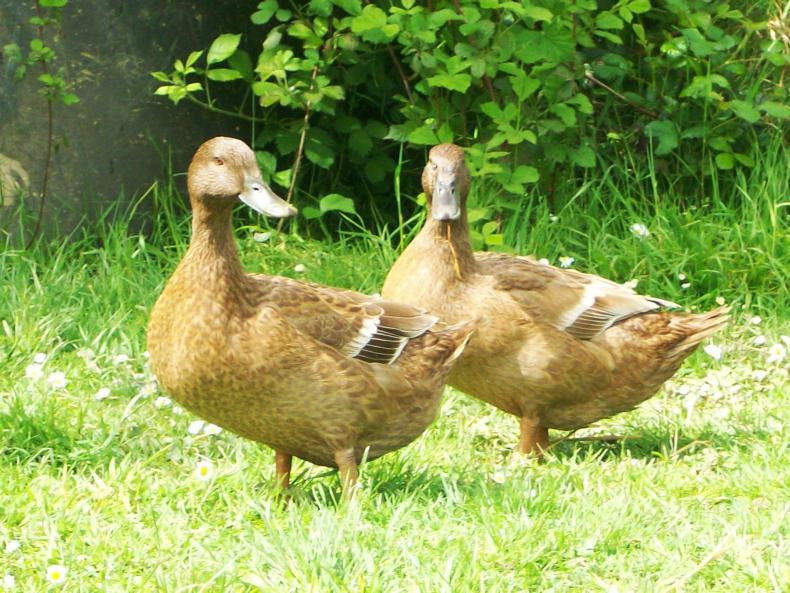Delighted to report that there are ducks back in our world after a brief hiatus. Regular readers may recall that Youngest Child received three Indian Runner ducklings for her birthday last year. Alas, things didn’t end well for the three ducks.
First of all a fox took two of them, and the survivor (Ferdinand) succumbed to a gruesome accident with a toppled hen house caused by Storm Ophelia. One would think that such a tragedy would make us think twice about keeping ducks at all, but we’re determined folk around these parts.
We were at the Cork Summer Show recently, with a show garden based on our TV series garden and a partnership with our friends from Field of Dreams (a project in Curaheen pioneered by Down Syndrome Cork, where three acres of land have been transformed into a place of on-going learning for adults with Down syndrome).
On one of my occasional rambles around the show grounds, I discovered O’Leary’s Poultry from Macroom selling hens, turkeys and ducks, and I returned home in triumph that night with six new point-of-lay hens and two little Khaki Campbell ducklings.
Though not quite as charismatic as the Indian Runner, the Khaki Campbell is one of the most prolific backyard ducks, with some of them literally laying an egg a day all year, contributing food for the table even when your hens have given up laying in the depths of winter.
Duck eggs have a poor reputation, a legacy of the fact that they caused a salmonella outbreak shortly after World War II. This is because their shells are porous and will absorb impurities from the surrounding environment. It’s important, therefore, to collect the eggs daily so that they don’t get fouled by the ducks poohing on them and give the eggs a clean before you put them in the egg tray.
The eggs are much larger than a hen’s egg and are therefore perfect in the kitchen, for baking and cooking. They are certainly richer than a hen’s egg, and for that reason many people don’t like them – I’m inclined to think that they are good to eat if you scramble them or use them in omelettes, but I am not a huge fan of a poached duck-egg, which is how I generally prefer my eggs cooked.
Ducks, unlike hens, are very talkative creatures, which lends them a considerable charm. They always seem to be giving out or fed up about something. Ducks also wag their tails or whatever the equivalent duck version of tail-wagging is (they sort of wag their entire backside), though I haven’t yet figured out whether they did that because they were pleased to see me or considered me a threat.
Perhaps because they didn’t have a drake around, the Indian Runners took quite a shine to our goofy Labrador, Sam. They would waddle after him and give out to him a bit, and then he’d play with them a little, chasing them all over the garden. That was fun to watch.
Given what happened to their predecessors, we will be keeping a careful eye on these new ones – and waiting patiently for the first duck eggs. CL
>> The basics: Growing cucumbers
I grow cucumbers exactly like tomatoes: planting them in the polytunnel and allowing them to climb (they can grow up to 2m high). I’ve tried to let them trail along the ground in the polytunnel, but they tend to get a bit out of control, trailing in to parts of the tunnel where you don’t want them. So, I think it’s better to go vertical with them.
When I dig the planting hole, I lay a long piece of twine in the hole, put the plant on top of the twine and then firm it in well – the twine is therefore anchored in the soil. I then tie the twine to a horizontal bar on the roof of the polytunnel. As the plant grows, you basically wind it around the twine. This is a far sturdier and more effective support than a bamboo cane.
Cucumber plants are incredibly prolific. A single plant produces more than 40 cucumbers over the summer. As a result, they are a hungry plant.
I dig lots of chicken manure pellets in to the planting hole, and when the plants starts producing cucumbers I give it a regular feed with comfrey tea.
Unlike tomatoes, they benefit from a humid environment, so watering their foliage as well as the base of the plants is a good plan.






 This is a subscriber-only article
This is a subscriber-only article










SHARING OPTIONS: